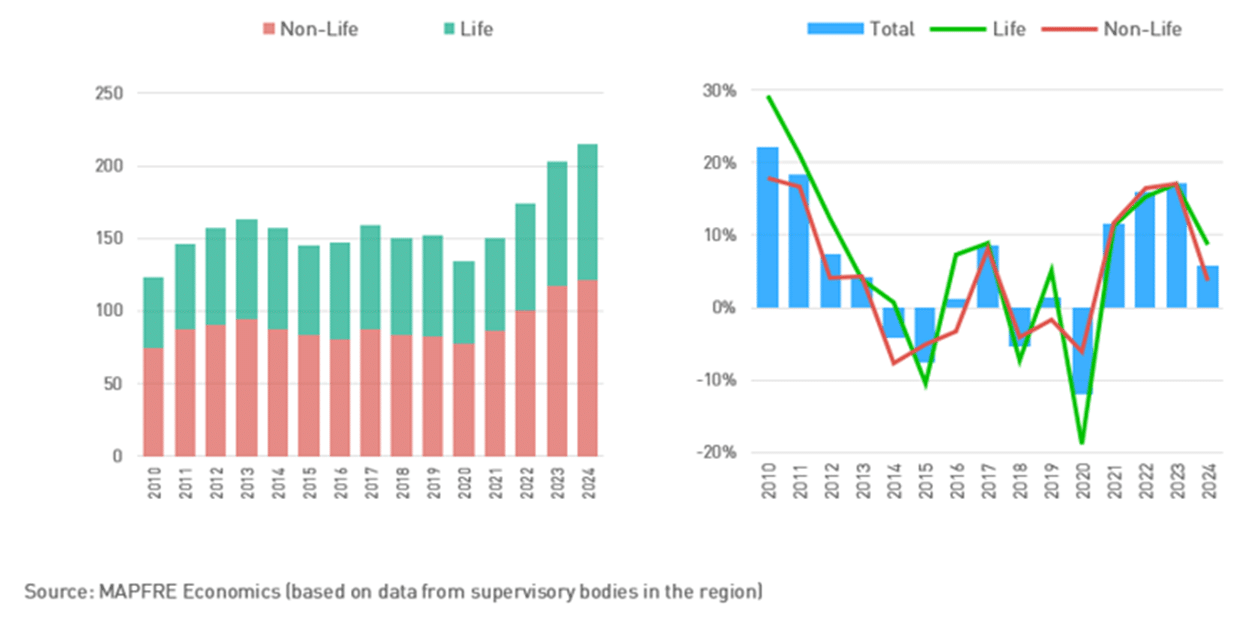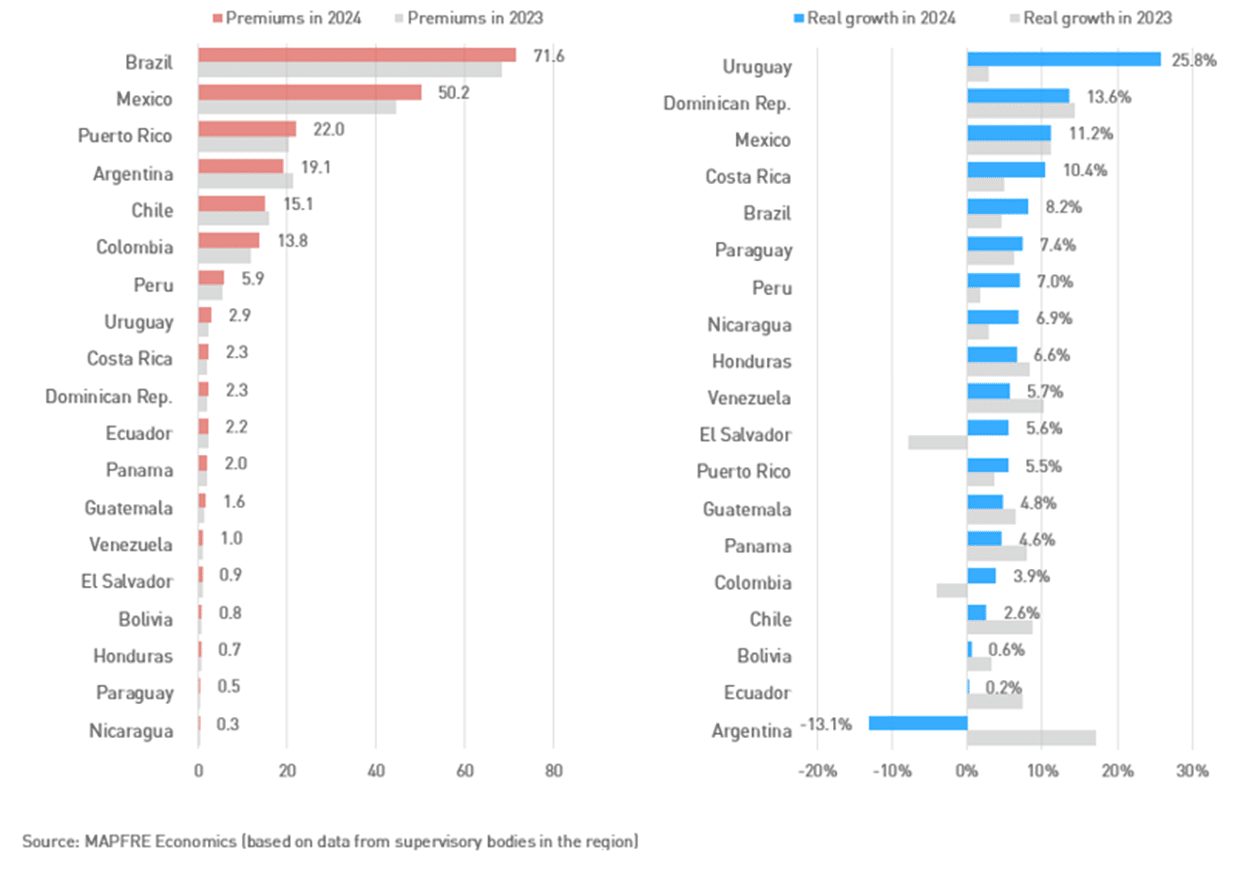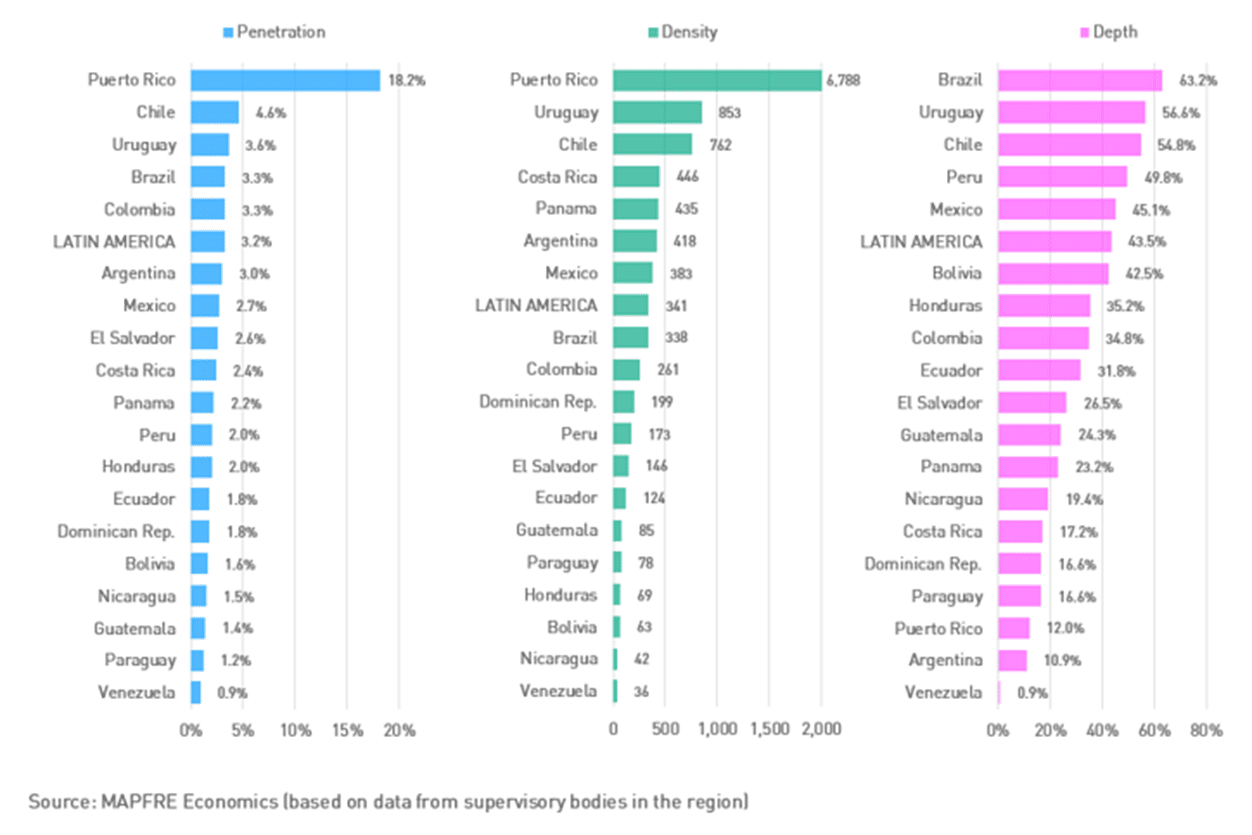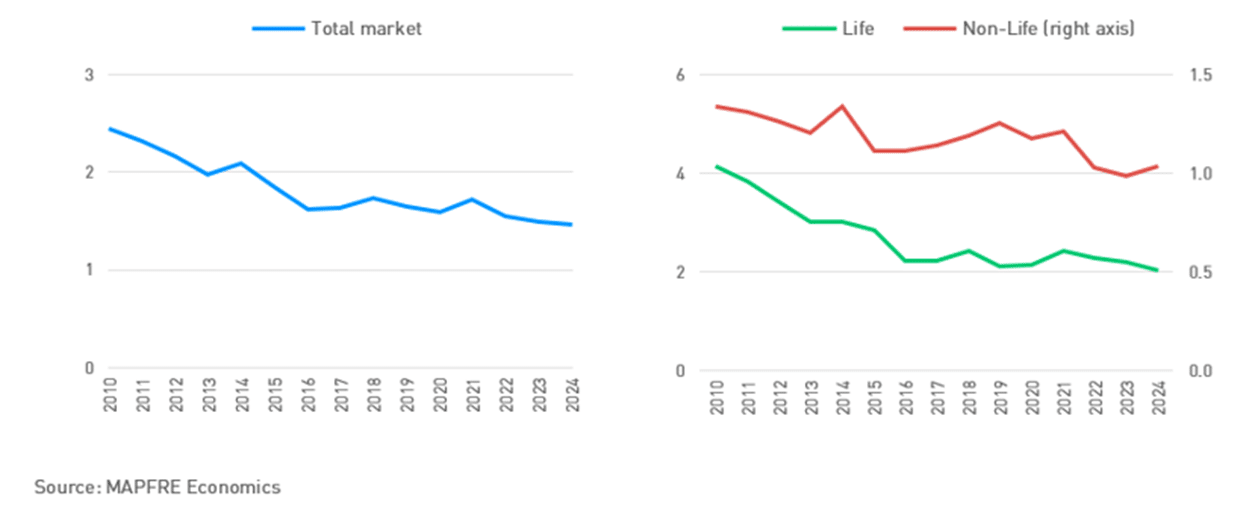The Latin American Insurance Market in 2024
Author: MAPFRE Economics
Summary of the conclusions of the
MAPFRE Economics report
The Latin American Insurance Market in 2024
Madrid, Fundación MAPFRE, October 2025
Latin America experienced moderate economic growth in 2024, lagging behind other emerging economies. This occurred in a context in which slowing domestic demand and the gradual easing of monetary policies from still-restrictive levels shaped the evolution of household and business spending. While inflation dropped in most countries, towards the targets of the region’s central banks, financing conditions remained tight, limiting the capacity for credit-driven growth and curbing economic dynamism somewhat. Against this backdrop, private consumption remained the main driver of regional activity; this, combined with a more stable financial environment, contributed to the performance of the insurance industry, which also benefited from interest rates that remained favorable for savings and pension products.
In this economic context, the Latin American insurance market experienced growth of 5.8% in 2024, with total premiums reaching 215.1 billion dollars; both the Life and Non-Life segments (see Chart 1) recorded significant increases. This performance saw Latin America’s share of the global insurance industry reach 2.8%, a slight decrease of 0.04 pp compared with 2023, with an improvement in the Life segment’s share and a decline in Non-Life. Even so, this remains a modest percentage considering the relative size of the region’s economy, which accounts for around 8% of global GDP.
Chart 1. The Latin American Insurance Market in 2024
(premiums, billions of USD; annual nominal growth rates in USD, %)

Premiums in the Life insurance segment showed positive growth of 8.7% in dollar terms in 2024 (17.1% in 2023). The same was true for Non-Life premiums, which also grew by 3.7% (compared to 17.1% in 2023). In the Life line of business, interest rates, although less restrictive than the previous year, continued to create a favorable environment for the growth of savings and pension products, including Life insurance savings plans and annuities. The Non-Life insurance segment was driven mainly by Health and Personal Accident insurance (up by 8.4% and 8.9%, respectively), both of which showed momentum. The Auto line, the largest by market share and the main growth driver of Latin American insurance activity in the previous two years, saw weaker growth in 2024 (2.6%), in line with the region’s modest economic expansion. Meanwhile, the Fire and Allied Lines segment also saw weak, but slightly higher, growth of 4.1%.
The performance of Latin America’s insurance industry in 2024, combined with easing inflation in most countries, resulted in real growth in premiums across nearly all markets. Argentina was the only country that saw decreases in premium income of 13.1% in real terms (see Chart 2).
Chart 2. Latin America: insurance market premiums and real growth
(billions of USD; real growth in local currency, %)

In terms of the profitability of the insurance sector, performance remained positive in 2024, although more moderate than the previous year. Aggregate net income stood at 14.5 billion dollars, representing a 7.4% decline compared with 2023—a year that had seen exceptionally high results. Net income for the year was positive across all markets in the region, with the exception of the Argentine insurance market. Brazil is worth particular mention, with 6.7 billion dollars despite a decline in its net result, followed by Mexico (4.4 billion), Colombia (1.0 billion), and Peru (0.8 billion).
As regards structural trends, Chart 3 shows a comparison of different countries in the region in terms of penetration, density, and depth, which measure the degree of progress and development of the Latin American insurance markets.
The insurance penetration rate in Latin America (premiums/GDP) stood at 3.2% in 2024, up by 0.1 percentage points on the previous year. This improvement was observed in both the Non-Life segment (1.80% compared with 1.78% in 2023) and the Life segment (1.39% compared with 1.31% the previous year). Puerto Rico continued to show the highest penetration and density levels in the region, recording values of 18.2% and 6,788 dollars, respectively. After Puerto Rico, Chile (4.6%), Uruguay (3.6%), Brazil (3.3%), and Colombia (3.3%) were the markets with the highest penetration rates in 2024, above the regional average. Over the medium term (2010–2024), the region recorded a cumulative increase in penetration of 0.8 percentage points, distributed evenly between the Life and Non-Life segments.
The density indicator (per capita premiums) for the region stood at 340.7 dollars in 2024, up by 5.0% on the previous year. Non-Life insurance density reached 192.6 dollars, while Life insurance density stood at 148.0 dollars. Between 2010 and 2024, density increased by 54.4% in the region, largely due to growth in recent years.
The insurance depth index (the ratio of Life insurance premiums to total premiums) was 43.5% in 2024, 1.2 percentage points above the level seen in 2023, on account of the greater dynamism of the Life segment. By country, declines were seen in Argentina, Costa Rica, El Salvador, Guatemala, and Panama between 2023 and 2024. From a medium-term perspective (2010–2023), improvement was seen, with a cumulative increase of 2.8 pp.
Chart 3. Latin America: penetration, density and depth indexes, 2024
(premiums/GDP, %; premiums per capita, USD; Life premiums/total premiums, %)

With regard to the Insurance Protection Gap (IPG)—defined as the difference between the level of insurance coverage that is economically necessary and beneficial for society and the amount of such coverage actually purchased—the estimate of this indicator for the Latin American insurance market in 2024 is 315.9 billion dollars, an increase of 4.2% compared with the 2023 estimate. As a structural measurement, the composition of the IPG shows no significant changes in recent years with respect to our previous report, confirming the predominance of Life insurance in its structure.
The potential insurance market in Latin America in 2024 (measured as the sum of the actual insurance market and the insurance gap in that year) was 531.1 billion dollars, equivalent to 2.5 times the current market in the region, the same relative figure as the previously year (see Chart 4).
Chart 4. Latin America: Insurance Protection Gap and potential market
(billions of USD)

Chart 5 presents the IPG in relative terms, i.e., as a multiple of the existing insurance market. According to this analysis, the region’s insurance gap between 2010 and 2024 showed a clearly decreasing trend in terms of both the total market (falling from 2.4 to 1.5 times the actual market during that period) as well as the Life segment (from 4.1 to 2.0 times the market) and the Non-Life category (from 1.3 to 1.0 times). This confirms the region’s medium-term trend toward convergence with the coverage levels of developed insurance markets.
Chart 5.Latin America: IPG as a multiple of the actual market
(number of times the size of the actual insurance market)

A full analysis of the structural trends and behaviors of the region’s insurance industry can be found in the report The Latin American Insurance Market in 2024, prepared by MAPFRE Economics and available at the following link:




